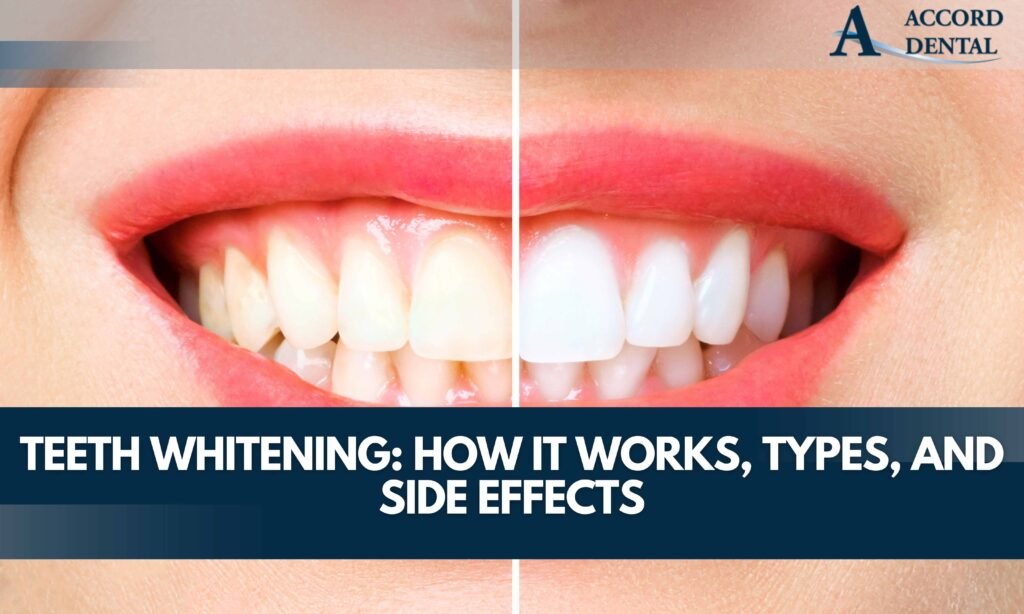A bright, radiant smile is often considered a sign of health, youth, and beauty. It’s no surprise that teeth whitening has become one of the most popular cosmetic dental procedures in recent years. People across the globe are opting for teeth whitening treatments, hoping to achieve a smile that’s as white as the celebrities they admire. Whether you’re considering whitening your teeth or just curious about the process, it’s important to understand how teeth whitening works, the types of treatments available, and any potential side effects. We will explore the various aspects of teeth whitening, from the science behind it to the different methods available, and the potential risks associated with these treatments. By the end of this article, you will be equipped with all the information needed to decide on the best approach to achieving a brighter, whiter smile.
What Is Teeth Whitening?
Teeth whitening refers to the process of lightening the color of the teeth to enhance their appearance. Over time, teeth naturally darken due to factors such as food, drinks, smoking, poor oral hygiene, aging, and even certain medications. Teeth whitening aims to remove or reduce these stains and brighten the natural color of your teeth.
The primary goal of teeth whitening treatments is to make the teeth appear whiter by breaking down or masking the stains that accumulate on the tooth surface (the enamel). Some whitening treatments even penetrate deeper into the enamel to address stains that lie below the surface, resulting in a more significant lightening effect.
How Teeth Whitening Works
Teeth whitening treatments typically involve the use of bleaching agents that help break down or oxidize stains on the enamel. The most common bleaching agents used are hydrogen peroxide and carbamide peroxide. These agents break down into oxygen molecules that react with the discoloration on the enamel, lifting stains and lightening the overall color of the teeth.
The Whitening Process
- Application of Bleaching Agent: The treatment begins with the application of a whitening gel, paste, or solution to the surface of the teeth. This product contains the active bleaching agent, such as hydrogen peroxide or carbamide peroxide.
- Penetration and Oxidation: The bleaching agent penetrates the enamel and breaks apart the molecules that cause discoloration. This process oxidizes the stains, making them less visible.
- Light or Heat Activation (Optional): Some in-office treatments include the use of light or heat to activate the bleaching agent, speeding up the process and enhancing the overall effectiveness.
- Immediate Results: In-office whitening often provides immediate, dramatic results, while at-home treatments may take a bit longer to show noticeable effects.
Understanding Stains: Extrinsic vs. Intrinsic
There are two main types of stains that can discolor your teeth:
- Extrinsic Stains: These stains affect the outer surface (enamel) of the teeth. They are often caused by consumption of foods and beverages such as coffee, tea, red wine, or tobacco products. Extrinsic stains can usually be removed with teeth whitening treatments, especially those involving bleaching agents.
- Intrinsic Stains: These stains affect the inner structure of the tooth (dentin). Intrinsic discoloration can be caused by aging, certain medications (such as tetracycline antibiotics), or trauma to the tooth. Intrinsic stains are harder to treat but can still be addressed with some professional whitening methods or dental veneers.
Types of Teeth Whitening Treatments
There are several types of teeth whitening treatments available today, ranging from professional services provided by a dentist to over-the-counter products that you can use at home. The method you choose will depend on your personal preferences, budget, and the extent of your tooth discoloration.
Professional In-Office Whitening
Professional teeth whitening, often performed in a dentist’s office, is the fastest and most effective option for whitening your teeth. During this procedure, a stronger bleaching agent is applied to the teeth, usually under the supervision of a dental professional. Some in-office treatments also use light or heat to accelerate the whitening process.
Pros of In-Office Whitening:
- Immediate Results: You can see dramatic whitening results in just one visit.
- Stronger Bleaching Agents: The higher concentration of bleaching agents used in the office is more effective for severe discoloration.
- Custom Treatment: A dentist can customize the whitening procedure based on your specific needs and monitor your comfort throughout the process.
Cons of In-Office Whitening:
- Cost: Professional treatments tend to be more expensive than at-home alternatives.
- Time Commitment: In-office whitening typically takes about an hour or more.
At-Home Whitening Kits
At-home whitening kits have gained popularity due to their convenience and affordability. These kits typically contain a whitening gel, strips, or trays that you apply to your teeth for a set period (typically 10 to 14 days). Many over-the-counter options are available, and some dentists offer custom-made kits.
Pros of At-Home Whitening Kits:
- Affordable: Less expensive than professional in-office treatments.
- Convenient: You can use the products at your own pace and on your own schedule.
- Variety: There are many different products available, including whitening strips, trays, and gels.
Cons of At-Home Whitening Kits:
- Slower Results: Results typically take longer compared to professional whitening treatments.
- Uneven Whitening: It can be difficult to apply the whitening gel evenly, especially if using strips or over-the-counter trays.
- Potential for Overuse: It’s easy to overuse at-home products, which may lead to tooth sensitivity.
Whitening Toothpaste
Whitening toothpaste is one of the simplest and most accessible teeth whitening options. It contains mild abrasives that help scrub away surface stains from the teeth. While whitening toothpaste can’t drastically lighten the teeth, it can help maintain the brightness of your smile by removing everyday stains.
Pros of Whitening Toothpaste:
- Affordable: Available at most stores and typically inexpensive.
- Easy to Use: Simply brush with the toothpaste as part of your daily oral care routine.
- Prevents New Stains: Helps to prevent new stains from developing on your teeth.
Cons of Whitening Toothpaste:
- Limited Effectiveness: It may only remove light surface stains and will not affect deeper or more persistent discoloration.
- May Cause Sensitivity: Some whitening toothpastes may cause tooth sensitivity, especially if used too often.
Over-the-Counter Whitening Strips
Whitening strips are thin, flexible plastic strips coated with a whitening gel that you apply to the surface of your teeth. These strips are designed for ease of use and typically require application for 30 minutes to an hour daily over a period of 10–14 days.
Pros of Whitening Strips:
- Convenient: Easy to apply and relatively mess-free.
- Affordable: Less expensive than professional treatments.
- Visible Results: You can expect to see some improvement after a few uses.
Cons of Whitening Strips:
- Uneven Whitening: Results can vary depending on how well the strips are applied.
- Potential Sensitivity: Some users experience tooth sensitivity during or after use.
Natural Teeth Whitening Methods
Natural teeth whitening methods, such as using baking soda, activated charcoal, or hydrogen peroxide, have become increasingly popular as people look for more natural alternatives. While these methods can help remove light stains, they are not as effective as professional treatments.
Pros of Natural Teeth Whitening:
- Affordable: You likely already have the ingredients in your home.
- Minimal Side Effects: These methods are less likely to cause sensitivity compared to stronger bleaching agents.
Cons of Natural Teeth Whitening:
- Minimal Results: These methods usually don’t provide dramatic results, especially for deeper stains.
- Can Be Abrasive: Some natural methods, such as baking soda, can be abrasive and may wear down enamel over time.
Side Effects of Teeth Whitening
While teeth whitening is generally safe, there can be some side effects to consider. The most common side effects of whitening treatments are:
Tooth Sensitivity
Tooth sensitivity is a common side effect of teeth whitening. The bleaching agents used in whitening treatments can temporarily make your teeth more sensitive to hot, cold, or sweet foods and drinks. This occurs because the bleaching agents can cause microscopic openings in the tooth enamel, exposing the underlying dentin.
How to Manage Sensitivity:
- Use toothpaste designed for sensitive teeth.
- Avoid extremely hot or cold foods and drinks during the whitening process.
- Reduce the frequency of whitening treatments if sensitivity persists.
Gum Irritation
During whitening treatments, some of the bleaching agent may come into contact with your gums, causing temporary irritation. This can be more common with at-home whitening products if not used properly.
How to Prevent Gum Irritation:
- Ensure that the whitening gel or product is applied carefully, avoiding direct contact with the gums.
- Follow the instructions provided with at-home products.
- Consult with your dentist about the best options for whitening if you have sensitive gums.
Uneven Whitening
Sometimes, teeth whitening can result in uneven whitening, particularly if certain areas of the teeth are exposed to the bleaching agent more than others. This can happen if the whitening tray or strips are not applied evenly.
How to Prevent Uneven Whitening:
- Ensure that you follow the instructions carefully when using at-home products.
- Professional whitening treatments can help ensure even results, especially for more stubborn stains.
Overuse of Whitening Products
Overusing teeth whitening products can lead to damage to the enamel, causing your teeth to become weakened and more vulnerable to decay. It’s important to follow the recommended usage instructions and give your teeth time to recover between treatments.
How to Prevent Overuse:
- Always follow the recommended guidelines for whitening products.
- Consider consulting with a dentist about how often you should whiten your teeth based on your unique needs.
Maintaining Your Whiter Smile
Once you’ve achieved a whiter smile, you’ll want to maintain it for as long as possible. Here are some tips for keeping your teeth white and healthy:
- Practice Good Oral Hygiene: Brush and floss regularly to remove plaque and surface stains.
- Limit Staining Foods and Drinks: Avoid excessive coffee, tea, red wine, and smoking, all of which can stain your teeth.
- Use Whitening Toothpaste: To prevent stains and keep your teeth bright, consider incorporating whitening toothpaste into your daily routine.
- Regular Dental Cleanings: Professional cleanings by a dentist help remove surface stains and keep your smile looking fresh.
Learn More: Teeth whitening in Grafton, MA
Conclusion
Teeth whitening is a safe and effective way to enhance the appearance of your smile. Whether you choose professional in-office treatments, at-home whitening kits, or natural remedies, the key is finding the option that works best for you. While side effects like tooth sensitivity and gum irritation are common, they are typically temporary and can be managed with proper care. If you’re looking to brighten your smile, Accord Dental, Dentist in Grafton, MA, is here to help. Our experienced team offers professional teeth whitening services that can give you the radiant smile you’ve always wanted. We will guide you through the whitening process, ensuring your treatment is safe, effective, and tailored to your needs. Contact us today to schedule a consultation and take the first step towards a brighter, more confident smile.






